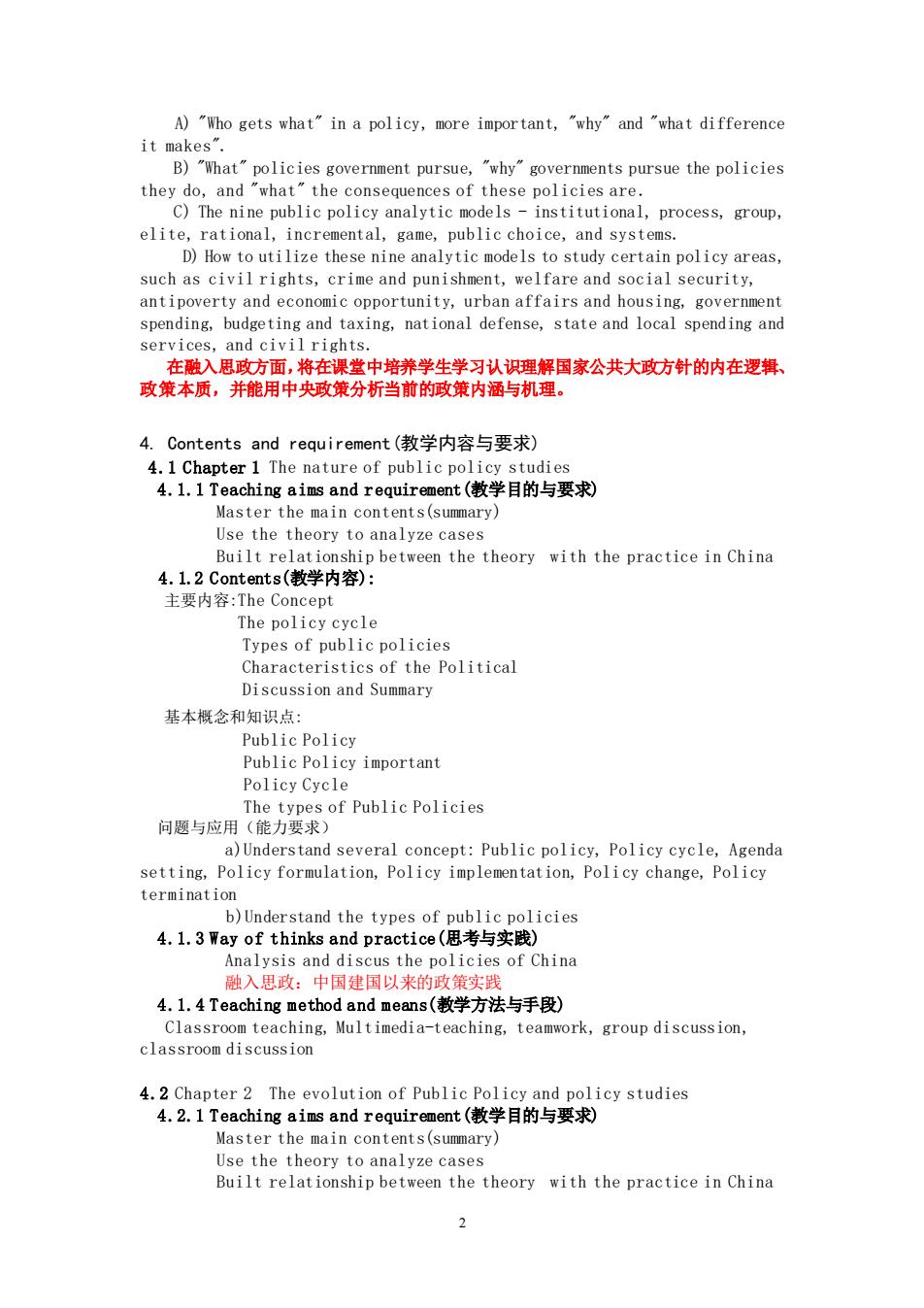正在加载图片...

A)"Who gets what"in a policy,more important,"why"and "what difference it makes". B)"What"policies government pursue,"why"governments pursue the policies they do,and "what"the consequences of these policies are. C)The nine public policy analytic models-institutional,process,group, elite,rational,incremental,game,public choice,and systems. D)How to utilize these nine analytic models to study certain policy areas, such as civil rights,crime and punishment,welfare and social security, antipoverty and economic opportunity,urban affairs and housing,government spending,budgeting and taxing,national defense,state and local spending and services,and civil rights. 在融入思政方面,将在课堂中培养学生学习认识理解国家公共大政方针的内在逻辑、 政策本质,并能用中央政策分析当前的政策内涵与机理。 4.Contents and requirement(教学内容与要求) 4.1 Chapter 1 The nature of public policy studies 4.l.1 Teaching aims and requirement(教学目的与要求) Master the main contents(summary) Use the theory to analyze cases Built relationship between the theory with the practice in China 4.1.2 Contents(教学内容): 主要内容:The Concept The policy cycle Types of public policies Characteristics of the Political Discussion and summary 基本概念和知识点: ublicPol cy important everal oncept:Public policy, setting,Policy formulation Policy cycle,Agenda Policy implementation,Policy change,Policy terminatio )Unde nd the type licies 4.1.3ma think pract 融入思政: 中国建国以来 4.1.4Teac ning method (教学 法与手段) tea ng,Multimedia-teaching,teamwork,group discussion classr 4.2 Chapter 2 The evolution of Public 4.2.1 ai an d require 学目的与 olicy studies t relati ze ca hin b tween the theory with the practice in China 2 2 A) "Who gets what" in a policy, more important, "why" and "what difference it makes". B) "What" policies government pursue, "why" governments pursue the policies they do, and "what" the consequences of these policies are. C) The nine public policy analytic models - institutional, process, group, elite, rational, incremental, game, public choice, and systems. D) How to utilize these nine analytic models to study certain policy areas, such as civil rights, crime and punishment, welfare and social security, antipoverty and economic opportunity, urban affairs and housing, government spending, budgeting and taxing, national defense, state and local spending and services, and civil rights. 在融入思政方面,将在课堂中培养学生学习认识理解国家公共大政方针的内在逻辑、 政策本质,并能用中央政策分析当前的政策内涵与机理。 4. Contents and requirement(教学内容与要求) 4.1 Chapter 1 The nature of public policy studies 4.1.1 Teaching aims and requirement(教学目的与要求) Master the main contents(summary) Use the theory to analyze cases Built relationship between the theory with the practice in China 4.1.2 Contents(教学内容): 主要内容:The Concept The policy cycle Types of public policies Characteristics of the Political Discussion and Summary 基本概念和知识点: Public Policy Public Policy important Policy Cycle The types of Public Policies 问题与应用(能力要求) a)Understand several concept: Public policy, Policy cycle, Agenda setting, Policy formulation, Policy implementation, Policy change, Policy termination b)Understand the types of public policies 4.1.3 Way of thinks and practice(思考与实践) Analysis and discus the policies of China 融入思政:中国建国以来的政策实践 4.1.4 Teaching method and means(教学方法与手段) Classroom teaching, Multimedia-teaching, teamwork, group discussion, classroom discussion 4.2 Chapter 2 The evolution of Public Policy and policy studies 4.2.1 Teaching aims and requirement(教学目的与要求) Master the main contents(summary) Use the theory to analyze cases Built relationship between the theory with the practice in China